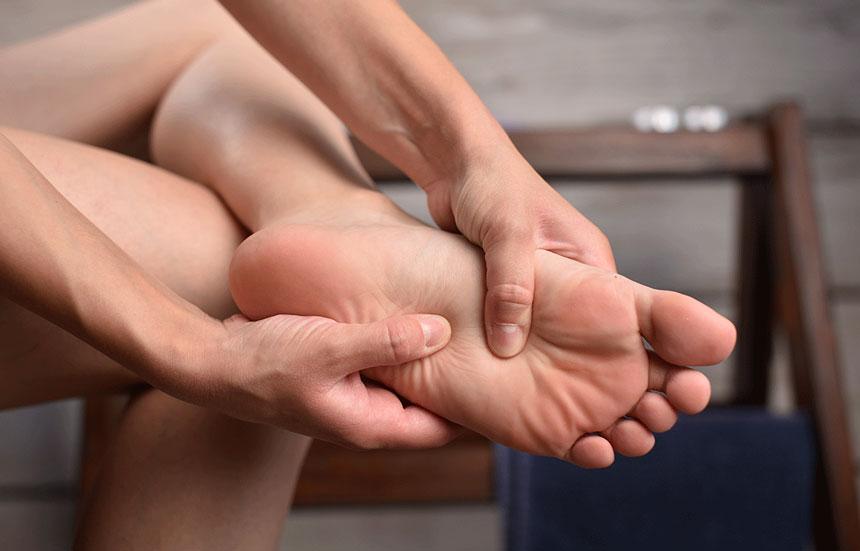Home Treatment for Painful Plantar Fasciitis

At the masters last year, plantar fasciitis sidelined Tiger Woods. But plantar fasciitis isn’t just an athlete’s problem. It’s a common problem that can develop in anyone, anytime of the year. However, many people are more susceptible to it during the warmer months as they participant in outdoor activities like walking while wearing sandals and flip flops that lack support. Now’s a good time to learn how to prevent and control this common condition.
What is Plantar Fasciitis?
The plantar fascia is a thick ligament that spans from the heel to the base of the toes. It supports the arch of the foot, assists with foot mechanics during walking and absorbs shock.
When it becomes inflamed, it can cause intense pain, stiffness and swelling on the bottom of the foot, around the heel and arch. The pain is usually triggered by running or walking and tends to be more problematic after rest or sleep. The pain can be so severe that it interferes with daily activities.
Inflammation may be caused by:
- Overuse. Over training, particularly in activities that place a heavy burden on feet such as running, walking or dancing, can cause repetitive stress and overuse damage. You also may experience this when just starting a walking or running program, as your feet are not used to the additional work.
- Type of shoes. Wearing unsupportive shoes can damage the plantar fascia. High heels, for example, lack support that distributes your weight evenly, strains the arch of the foot and tighten the Achilles tendon. Many styles of summer shoes also lack support for the plantar fascia.
- Hard surfaces. Standing on surfaces such as concrete, asphalt and marble apply pressure on the plantar fascia. Of course, repetitive impact of the heel on a hard surface when walking and running creates even more pressure.
- Foot structure. Having low arches/flat feet or high arches affects how weight is distributed, ultimately placing pressure on the plantar fascia.
- Barefoot walking. Being barefoot doesn’t support the plantar fascia and contributes to the wearing of fat pads on the heels.
- Extra pounds. Being overweight puts a lot of pressure on your heel pads, inflaming the plantar fascia. People with a BMI of 30 or higher have a six-time higher risk for plantar fasciitis compared to those with healthier weights.
- Diabetes. Having high sugar levels triggers inflammation that increases the thickness of the plantar fascia, leading to plantar fasciitis.
- Arthritis. Having rheumatoid arthritis (RA) raises inflammation that affects the plantar fascia. The fat pads that protect the heel also erode as RA progresses. But it isn’t just RA that’s a problem. Inflammation associated with other forms of arthritis also have been linked to plantar fasciitis.
“I’ve had quite a few patients with plantar fasciitis,” says Bernard Kaminetsky, MD, medical director, MDVIP. “As their primary care physician, I would partner with them to help them address conditions that affect the plantar fasciitis and teach them self-care.”
Home Treatments
If you’re experiencing heel and foot pain, try to:
Wear supportive footwear – to help support the arch, easing strain on the plantar fascia. If you’re not sure which footwear works best, read the experts’ choice in shoes for plantar fasciitis >>
Lose weight – to help alleviate the pressure on the feet. Need a little help? Check out MDVIP’s weight loss resource center >>
Cross train – to help you remain active and manage your weight without aggravating your feet. Choose plantar fasciitis friendly activities like swimming, cycling or water aerobics.
Rest – to help heal the plantar fascia. Avoid high impact activities, particularly running and jumping. If you don’t want to give up exercising altogether, engage in low impact workouts.
Ice – to help reduce swelling and pain. Keep a cloth-covered ice pack on the painful area for 20 minutes. You can do this several times a day.
Footwork – to help ease the pain associated with walking after rest periods such as sleeping and sitting. Before getting out of bed or chair, slowly point and flex your feet. Next, hold the point and flex for 10 seconds each and add some ankle circles. End by massaging your feet.
Stretch and strengthen – to help keep your feet healthy. Stretching loosens the plantar fascia, helping prevent it from tearing. Strengthening the muscles that support the plantar fascia can ease the stress and inflammation on the ligament. You can find lower body stretches and strengthening exercises on MDVIP Connect.
Pain relievers – to alleviate pain. Over-the-counter pain relievers like ibuprofen, aspirin and naproxen can be effective in lowering inflammation. Talk to your doctor before taking medications.
“Continue working with your primary care doctor – even if the home treatments seem to be working,” says Kaminetsky. “While the condition can heal on its own, complications are common, and you may need a referral to a physical therapist, podiatrist or orthopedic physician for taping, orthotics or a boot.”
If you don’t have a primary care doctor, consider joining an MDVIP-affiliated practice. MDVIP-affiliated doctors have the time to work with you to focus on your health and wellness. Find a physician near you and begin your partnership in health »


